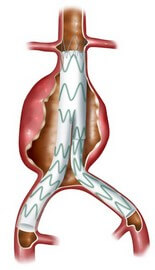Endovascular aneurysm repair involves inserting a graft within the aneurysm through small groin incisions using X-rays to guide the graft into place.
The advantage of this type of repair is that there is no abdominal surgery. This technique is therefore safer than the traditional operation, and you need to spend less time in hospital. A disadvantage is that some patients have to undergo a further operation at a later stage to refine the initial procedure.

Not every patient or every aneurysm is suitable for EVAR. In particular, aneurysms arising close to or above the kidneys are more difficult to treat in this way. You will be assessed with a scan to determine if your aneurysm can be treated by endovascular repair. If suitable you will be offered a choice of type of repair by your surgeon. If this cannot be undertaken at your local hospital, you may need to travel to a centre that can perform endovascular repair.
Complications: The risk of a major complication is lower for endovascular repair, as the operation does not interfere with the circulation as much as open surgery. However, the graft attachment is not as secure as in the open operation. As a result, you may need follow up with scans to ensure that the graft has not slipped. It is estimated that about 1 in 10 patients may need a further intervention or operation on their graft.
Recovery: After uncomplicated endovascular repair, most patients return to the hospital ward for one to three days. You should be able to eat and drink normally once fully awake following your aneurysm repair. The nurses will aim to getting you sitting up and walking as soon as possible. Once you are up and about, you should be able to leave hospital, but may need painkilling tablets for up to a week.
Discussions with patients who have undergone endovascular repair suggest that it can be normal to make a full recovery in about two weeks, however some people take longer and can tire and take several months to return to the health state they had prior to the operation. During this time, you should gradually build up your level of activity back to normal. You may resume normal sexual relations as soon as you as you feel comfortable.
Is surgery successful?
If aneurysms are successfully repaired, this prevents them blocking or bursting and there is a very high likelihood that you will return to a normal life. Full recovery takes between 3 and 6 months after open surgery and 2 to 4 weeks after endovascular repair. The speed of recovery will also be affected by your age and general fitness.
What are the risks of surgery?
As with any major operation general complications can occur including infection in the wound, chest infections or diarrhea.
There is a small risk of you having a medical complication such as:
- Heart attack
- Stroke
- Kidney failure
- Chest problem
- Loss of circulation in the legs or bowel
- Infection in the graft used to replace your aorta
Up to 1 in 10 men may have difficulty sustaining an erection following surgery due to injury to nerves which lie on the front of the aorta. It is also recognized to occur following endovascular repair. If you have problems with this, please tell your doctor, as there are treatments that may help.
Deep vein thrombosis (DVT) is a recognised risk and most patients will have treatment during their stay in hospital to prevent this. If you do develop a DVT, then you may require extra treatment for this and this may prolong your stay in hospital
If your risk of a major complication is higher than this, usually because you already have a serious medical problem, your surgeon will discuss this with you. It is important to remember that your surgeon will only recommend treatment for your aneurysm if he or she believes that the risk of the aneurysm bursting is higher than the threat posed by the operation.
